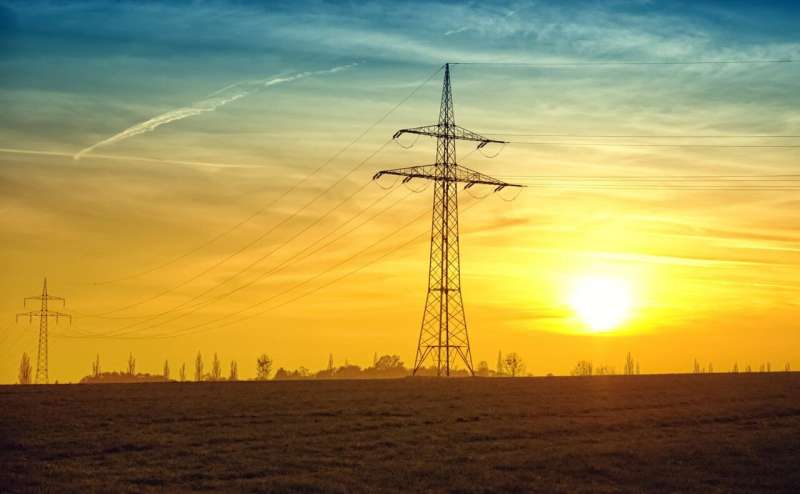Credit: Pixabay/CC0 Public Domain
Summer heat waves across the country tested whether America's aging electrical grid can keep up with demand—a problem scientists say will be exacerbated by climate change, as severe hurricanes, wildfires and other weather events occur more frequently, disrupting electricity generation and transmission.
Meeting the growing electricity needs of American consumers requires greater generation and transmission capacity, increased resiliency and smarter management.
The DU Newsroom asked Amin Khodaei, director of KLab and professor of electrical and computer engineering at the University of Denver's Ritchie School of Engineering and Computer Science, how new technologies, smart grids and active consumers can prepare the grid for climate change.
What challenges does climate change pose to our current electrical grid?
Safety, leisure, work, and now more than ever, education heavily depend on a power grid that can supply and provide electricity without interruption. However, climate-change-induced extreme weather events and natural disasters are disrupting the grid and posing multiple challenges to its operation.
The electric power grid has been traditionally designed with two objectives in mind: reliability and economics. Reliability represents the grid's ability to continue electricity supply and delivery in case of limited equipment outages—for example, if one or two transmission lines are out of service. The grid's economic objective represents selecting the lowest-cost generation mix to produce electricity considering the physical and technical limitations of the grid and various generation units. Electric utilities have been successful for the most part in achieving these two objectives over the past century. However, the growing frequency and intensity of climate-induced disasters necessitate considering another equally important objective: resilience. Resilience is defined as the ability of a power grid and its components to withstand and adapt to disruptive events and rapidly recover from them. Achieving resilience is expensive, and the increasing number of disasters only make it worse.
How can the current grid be adapted or upgraded to ensure resilient and reliable electricity?
There are three factors driving future grid needs and challenges. The first two are climate change and the changing energy supply landscape that I talked about. The third is around consumers. The way that consumers are using electricity is changing. There is a growing need for higher quality power for consumers' digital devices. Consumers are also installing more and more local generation, including rooftop solar panels and residential energy storage systems, causing a two-way flow of electricity for the first time ever, from customers to the upstream grid. The growing use of electric vehicles is another major change, which could potentially double the peak demand of a residential consumer, necessitating grid upgrades.
The grid is required to enhance its capabilities at three layers of physical, cyber and decision making to address these challenges. The physical layer needs new technologies such as real-time monitoring devices and microgrids to provide local intelligence to better manage distributed resources. The cyber layer needs updated communications and cybersecurity measures to deal with the digitalized grid. And the decision-making layer needs a significant overhaul to leverage state-of-the-art technologies, such as artificial intelligence and advanced computing.
How does the grid need to be changed to bring new renewable and reliable energy resources online?
Electricity production is responsible for 25% of greenhouse gas emissions, right after the transportation sector at 27%. Besides the extensive negative societal impacts, these emissions exacerbate the climate change that would further disrupt grid operation. It is vital to reduce these emissions—something that should be done by leveraging clean, renewable energy resources such as wind and solar.
Although these resources are clean, renewable and becoming increasingly cost-effective, they pose a few technical challenges to the grid. The first challenge is generation intermittency and volatility, meaning that they cannot produce electricity at all times, and the electricity production can significantly fluctuate within seconds. The grid needs to be upgraded to handle such fluctuations by installing fast response units, mainly gas-powered, or energy storage, which is costly. The second challenge is the lack of inertia. The traditional thermal generation units rely on electromechanical energy conversion through rotating elements, offering a mechanical inertia that can be offered to ride-through small load variations. This is necessary to keep the grid stable. Wind and solar energy resources do not offer inertia, hence cannot support grid stability. Recent advances in power electronics, i.e., high-power electronics used to connect wind and solar generation with the gird, provide viable solutions to this challenge.
Will consumer behavior need to change with the grid?
Consumer behavior is in fact changing, turning consumers from traditionally passive players in the grid to more active players that could react to grid conditions. If an outage in the grid disrupts the electricity delivery, the future consumer will automatically switch to its own generation to locally address that outage. If there is no outage, the future consumer will sell electricity back to the grid and be paid for its contribution to the grid supply.
However, an active consumer can play a much more vital role in grid operation. Many of the grid's technical challenges—for example the renewable generation fluctuation—need for improved resilience, and even system recovery after disasters, can be addressed by active consumers. To simplify it substantially, think of what Uber did for transportation. The way that Uber provided a viable and additional option for transportation, active consumers can provide multiple sustainable services for a more reliable, resilient, efficient and clean power grid.
Provided by University of Denver
























